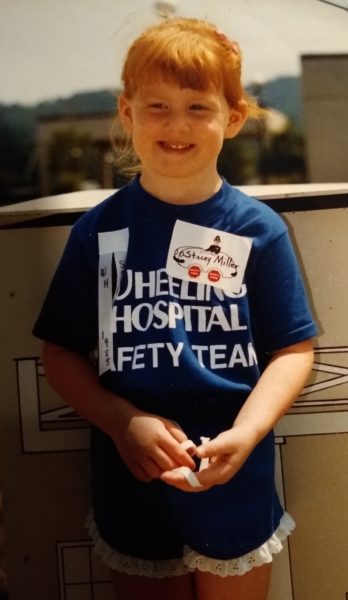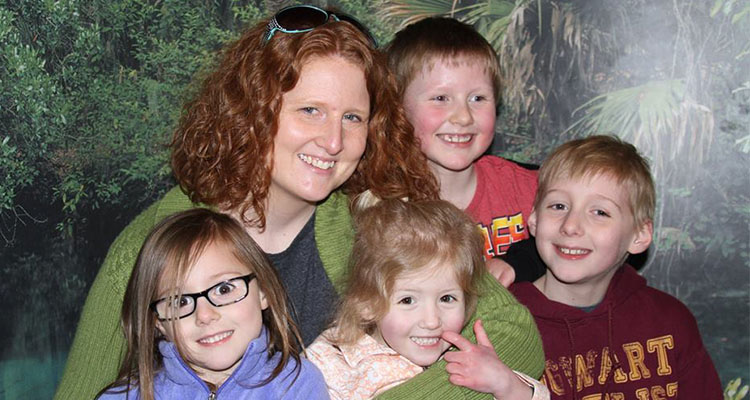Editor’s note: Redheaded men, women and children will be celebrated at the Wheeling YWCA’s Ohio Valley Redhead Festival on Saturday, Nov. 2. Here’s a first-hand account of being an “awesomely rare” redhead by Weelunk writer Stacey Sacco.
I come from a family of redheads. Both of my parents had red hair, but their obstetrician told them their chances of having a baby with red hair were slim. Well, we proved those 40-year-old medical theories wrong, and they had four ginger babies. The red hair gene is recessive, so both parents need to have the gene for a baby to have any chance at all of being a redhead. But having a redheaded parent is not a guarantee.
Case in point — I now have four children and not a strand of red among them. Thanks to my husband’s dominate genes, I’m stuck hoping for a redheaded grandbaby — many, many years from now. In fact, of my parents’ 10 grandkids, we are still only holding out hope that the youngest may turn out to be a ginger. Ten percent. That’s all we’re getting from 100 percent redheaded grandparents.
Only about two percent of the world’s population has red hair. Most redheads are ethnically German or Celtic. The area with the highest percentage of redheads is Ireland at just 10 percent. Yes, that makes us awesomely rare.

It also makes us more susceptible to a variety of conditions.
We all know that there is no middle ground when it comes to the sun and redheads. My options are ghostly pale or lobster red. Not only is a painful sunburn the consequence of not remembering the SPF 100 sunscreen, but it greatly increases our chances of skin cancer. We have less of the chemical in our skin that absorbs UV radiation before it can damage cells. Redheads are one and half times as likely to have basal cell carcinoma, which is the most prevalent form of skin cancer. We are also 12 times as likely to develop squamous cell carcinoma, which is even more aggressive.

Having red hair is actually a gene mutation. The brighter red your hair, the more of the mutation you carry. This gene mutation also carries a greater genetic risk of melanoma. Recent research likens having red hair to an extra 21 years of sun exposure.
Recent research likens having red hair to an extra 21 years of sun exposure.
This also means that we are very likely to be covered in freckles. Exposure to sunlight increases melanin production, and a group of cells darkens. Freckles can appear on all skin types, but are much more common in those with fair skin. Freckles themselves are not a problem, just a sign that skin is sensitive to sun exposure. And if you love them or hate them, there really is no treatment to get rid of them. Freckles tend to fade with age, but no amount of lemon juice or magic lotion will rid you of them completely.
However, our pale skin enables us to more effectively use the little vitamin D we can safely get. The gloomy climate of the British Isles adapted us to a lack of sunshine, just like West Virginia in the winter.
Redhead are more sensitive to pain and need more anesthetic to block pain. It’s not your imagination — things really do hurt more when you’re a ginger.

Redhead’s pale skin bruises more easily, and it’s a common misconception that they bleed more during and after surgery. But every time I enter a hospital, whether for having a baby or just a routine procedure, nurses tell me they will watch carefully for excessive bleeding because redheads scare them.
More than being an identifying characteristic like being blonde or brunette, being a redhead is part of your personality.
Even if we wanted to change our color, redheads are stuck with what they’ve got. Maggie of Martins Ferry acknowledges that she “can’t do as much with it, like if I wanted to dye it. Other colors can be more creative.” That’s because red hair holds its pigment more than any other color. If you want to be rid of the red, you have to first strip the color out completely.
And, of course, we can’t forget about the fiery temper to match the hue of the hair. One of my childhood favorites, Anne Shirley from Anne of Green Gables, is known for her temper and her hatred of her bright red hair. It’s a common and acceptable stereotype that redheads have terrible tempers. I’m not one to refute this because I can be very quick-tempered. But there’s really no hard science to back that up. Personally, I blame my nasty temper on my dad. My red-haired mother was possibly the gentlest soul ever.

As an adult, most gingers love their hair. They stand out in a crowd as unique. Other people are jealous of the rich color of a natural red. But as a kid, it’s a very different story. Being unique and standing out is not a teen’s favorite thing. Ron of Wheeling remembers hearing the rhyme, “I’d rather be dead than red on the head.” Kathy of Washington, Pennsylvania, was told redheads are always “the other woman.” And we have all been asked inappropriately personal questions related to our hair color.
From being called Pippi Longstocking to being compared to awkward Ron Weasley, taunting redheads still seems to be acceptable. In literature as early as Jonathan Swift’s Gulliver’s Travels, redheads have been labeled as “mischievous,” and during the Middle Ages, red hair was supposedly a sign of being a witch.
If you want to learn even more about redheads and have the chance to be surrounded by a population that is usually in the minority, join YWCA Wheeling for the inaugural Ohio Valley Redhead Festival from noon to 5 p.m. Saturday, Nov. 2. Highland games will be fun for the whole family, and dermatologists will provide screening for skin cancer. Funds raised will benefit programs that support youths who experience bullying, including gingers who are criticized rather than admired. All are welcome to attend the afternoon activities.

• Stacey Sacco is a Wheeling native currently living in Martins Ferry with her husband and four children. She graduated with a bachelor’s degree in social work and previously worked for several social service agencies. She is the production editor for InWheeling Magazine.


